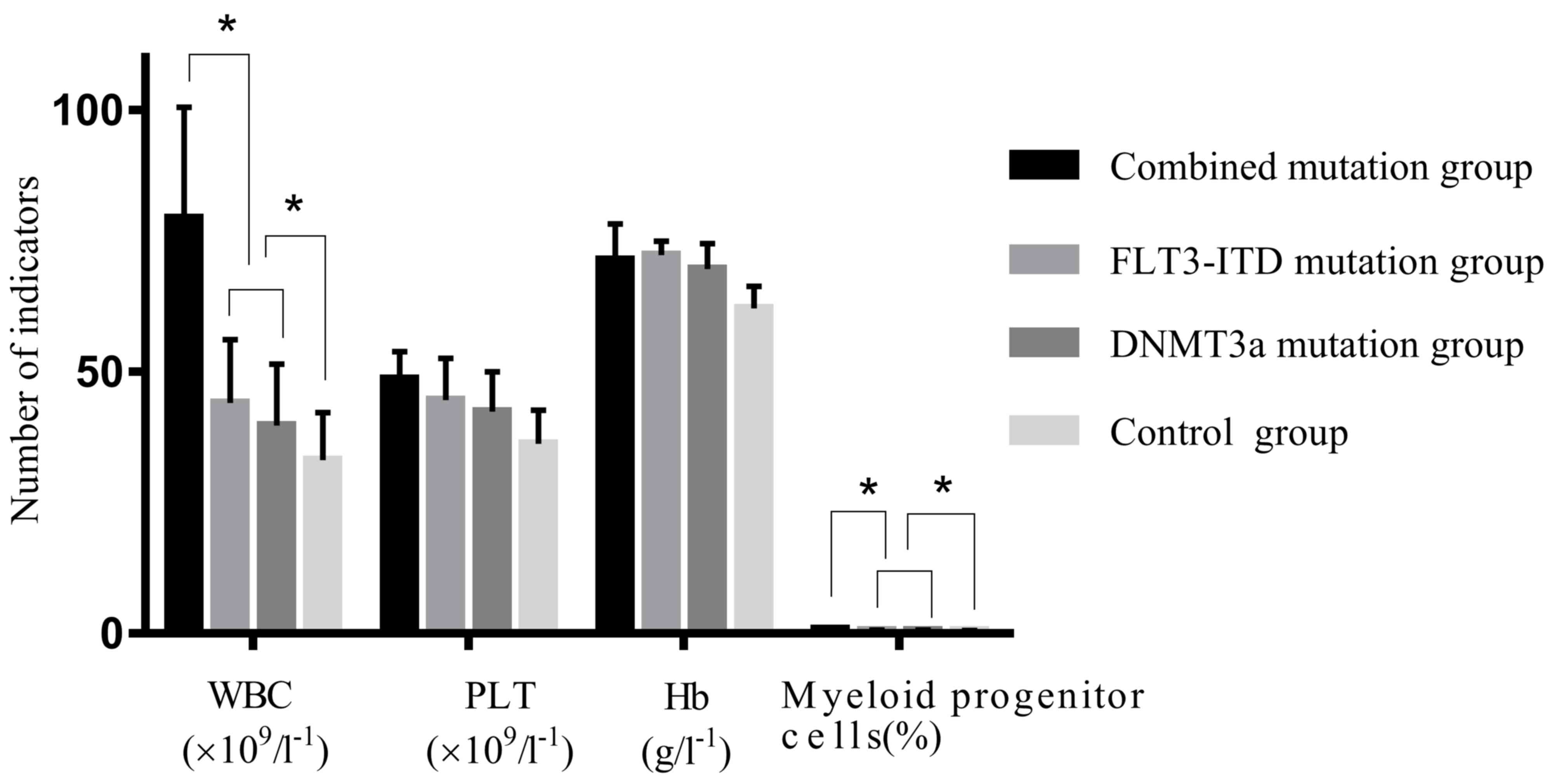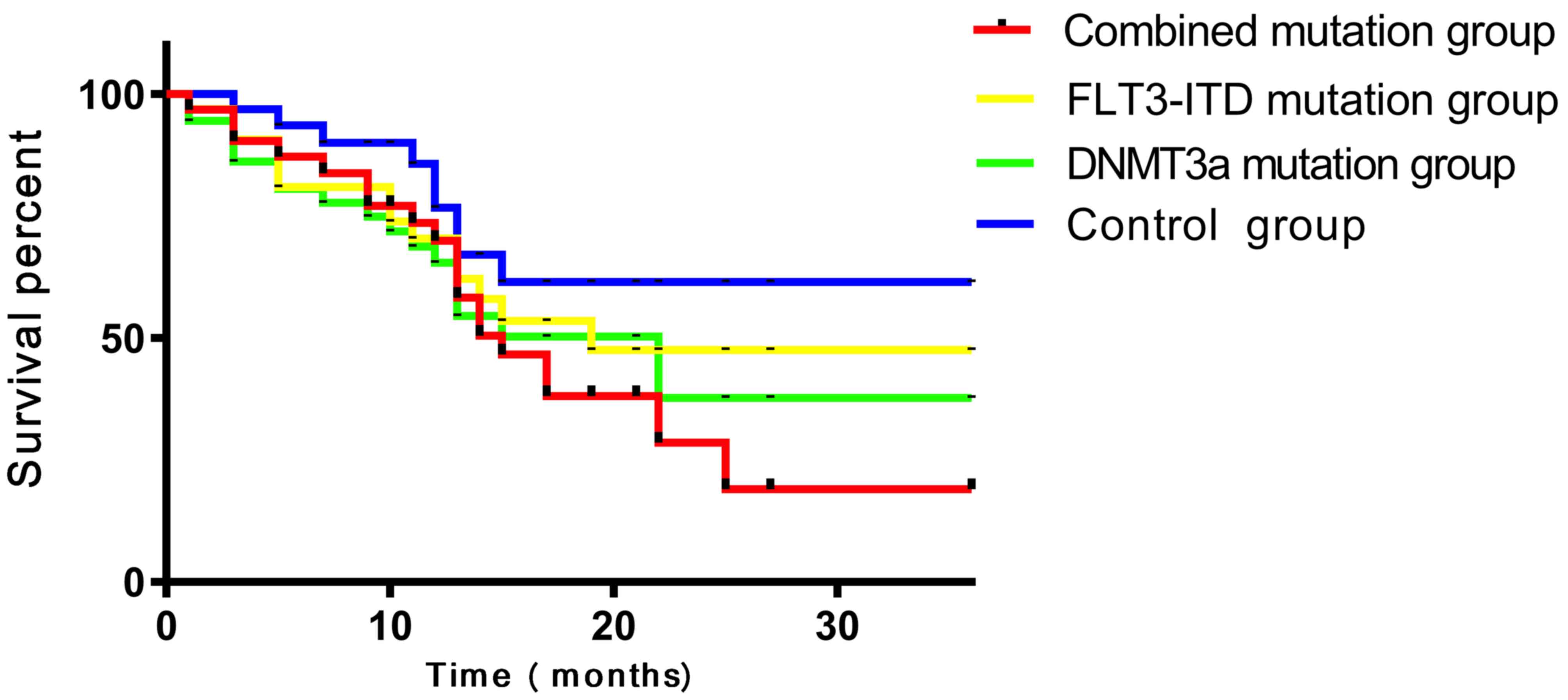|
1
|
Döhner H, Weisdorf DJ and Bloomfield CD:
Acute myeloid leukemia. N Engl J Med. 373:1136–1152. 2015.
View Article : Google Scholar : PubMed/NCBI
|
|
2
|
Mrózek K, Heinonen K and Bloomfield CD:
Clinical importance of cytogenetics in acute myeloid leukaemia.
Best Pract Res Clin Haematol. 14:19–47. 2001. View Article : Google Scholar : PubMed/NCBI
|
|
3
|
Papaemmanuil E, Gerstung M, Bullinger L,
Gaidzik VI, Paschka P, Roberts ND, Potter NE, Heuser M, Thol F,
Bolli N, et al: Genomic classification and prognosis in acute
myeloid leukemia. N Engl J Med. 374:2209–2221. 2016. View Article : Google Scholar : PubMed/NCBI
|
|
4
|
Wolach O and Stone RM: Acute myeloid
leukemia. Target Ther Transl Cancer Res. 5:892015. View Article : Google Scholar
|
|
5
|
Stone RM, Mandrekar SJ, Sanford BL,
Laumann K, Geyer S, Bloomfield CD, Thiede C, Prior TW, Döhner K,
Marcucci G, et al: Midostaurin plus chemotherapy for acute myeloid
leukemia with a FLT3 mutation. N Engl J Med. 377:454–464. 2017.
View Article : Google Scholar : PubMed/NCBI
|
|
6
|
Kao HW, Liang DC, Kuo MC, Wu JH, Dunn P,
Wang PN, Lin TL, Shih YS, Liang ST, Lin TH, et al: High frequency
of additional gene mutations in acute myeloid leukemia with MLL
partial tandem duplication: DNMT3A mutation only is associated with
poor prognosis. Oncotarget. 6:33217–33225. 2015. View Article : Google Scholar : PubMed/NCBI
|
|
7
|
Ferreira HJ, Heyn H, Vizoso M, Moutinho C,
Vidal E, Gomez A, Martínez-Cardús A, Simó-Riudalbas L, Moran S,
Jost E and Esteller M: DNMT3A mutations mediate the epigenetic
reactivation of the leukemogenic factor MEIS1 in acute myeloid
leukemia. Oncogene. 35:3079–3082. 2016. View Article : Google Scholar : PubMed/NCBI
|
|
8
|
Debarri H, Lebon D, Roumier C, Cheok M,
Marceau-Renaut A, Nibourel O, Geffroy S, Helevaut N, Rousselot P,
Gruson B, et al: IDH1/2 but not DNMT3A mutations are suitable
targets for minimal residual disease monitoring in acute myeloid
leukemia patients: A study by the acute leukemia french
association. Oncotarget. 6:42345–42353. 2015. View Article : Google Scholar : PubMed/NCBI
|
|
9
|
Gaidzik VI, Weber D, Paschka P, Kaumanns
A, Krieger S, Corbacioglu A, Krönke J, Kapp-Schwoerer S, Krämer D,
Horst H, et al: DNMT3A mutant transcript levels persist in
remission and do not predict outcome in patients with acute myeloid
leukemia. Leukemia. 32:30–37. 2018. View Article : Google Scholar : PubMed/NCBI
|
|
10
|
Im AP, Sehgal AR, Carroll MP, Smith BD,
Tefferi A, Johnson DE and Boyiadzis M: DNMT3A and IDH mutations in
acute myeloid leukemia and other myeloid malignancies: Associations
with prognosis and potential treatment strategies. Leukemia.
28:1774–1783. 2014. View Article : Google Scholar : PubMed/NCBI
|
|
11
|
Marhäll A, Heidel F, Fischer T and
Rönnstrand L: Internal tandem duplication mutations in the tyrosine
kinase domain of FLT3 display a higher oncogenic potential than the
activation loop D835Y mutation. Ann Hematol. 97:773–780. 2018.
View Article : Google Scholar : PubMed/NCBI
|
|
12
|
Fleischmann M, Schnetzke U, Schrenk KG,
Schmidt V, Sayer HG, Hilgendorf I, Hochhaus A and Scholl S: Outcome
of FLT3-ITD-positive acute myeloid leukemia: Impact of allogeneic
stem cell transplantation and tyrosine kinase inhibitor treatment.
J Cancer Res Clin Oncol. 143:337–345. 2017. View Article : Google Scholar : PubMed/NCBI
|
|
13
|
Ortlepp C, Steudel C, Heiderich C, Koch S,
Jacobi A, Ryser M, Brenner S, Bornhäuser M, Brors B and Hofmann WK:
Autotaxin is expressed in FLT3-ITD positive acute myeloid leukemia
and hematopoietic stem cells and promotes cell migration and
proliferation. Exp Hematol. 41:444–461.e4. 2013. View Article : Google Scholar : PubMed/NCBI
|
|
14
|
Levis MJ, Perl AE, Altman JK, Gocke CD,
Bahceci E, Hill J, Liu C, Xie Z, Carson AR, McClain V, et al: A
next-generation sequencing-based assay for minimal residual disease
assessment in AML patients with FLT3-ITD mutations. Blood Adv.
2:825–831. 2018. View Article : Google Scholar : PubMed/NCBI
|
|
15
|
Bashasha SH, Kordofani AA, Osman IM, Musa
OH, Altayb HN and Elmagbool BK: Prevalence of the different FAB sub
type of acute myeloid leukemia related to hematological parameters
in Sudanese. J Hematol Blood Disord. 3:1022017.
|
|
16
|
Meyerson H, Sundaram S and Lazarus HM:
Bone marrow structure and marrow aspiration, biopsy, and collection
for therapeutic intent proceduresLazarus H and Schmaier A: Concise
guide to hematology. Springer; Cham: pp. 233–252. 2019, View Article : Google Scholar
|
|
17
|
Wen H, Yuan L, Wei C, Zhao Y, Qian Y, Ma
P, Ding S, Yang X and Wang X: Effects of combined exposure to
formaldehyde and benzene on immune cells in the blood and spleen in
Balb/c mice. Environ Toxicol Pharmacol. 45:265–273. 2016.
View Article : Google Scholar : PubMed/NCBI
|
|
18
|
Schwartz LH, Litière S, de Vries E, Ford
R, Gwyther S, Mandrekar S, Shankar L, Bogaerts J, Chen A, Dancey J,
et al: RECIST 1.1-update and clarification: From the RECIST
committee. Eur J Cancer. 62:132–137. 2016. View Article : Google Scholar : PubMed/NCBI
|
|
19
|
Ossenkoppele G: Acute myeloid leukemia.
HemaSphere. 2:112018.
|
|
20
|
Tsai CH, Hou HA, Tang JL, Kuo YY, Chiu YC,
Lin CC, Liu CY, Tseng MH, Lin TY, Liu MC, et al: Prognostic impacts
and dynamic changes of cohesin complex gene mutations in de novo
acute myeloid leukemia. Blood Cancer J. 7:6632017. View Article : Google Scholar : PubMed/NCBI
|
|
21
|
Lyman SD, James L, Zappone J, Sleath PR,
Beckmann MP and Bird T: Characterization of the protein encoded by
the flt3 (flk2) receptor-like tyrosine kinase gene. Oncogene.
8:815–822. 1993.PubMed/NCBI
|
|
22
|
Altman JK, Perl AE, Cortes JE, Smith CC,
Litzow MR, Hill JE, Larson RA, Liu C, Ritchie EK, Strickland SA, et
al: Deep molecular response to gilteritinib to improve survival in
FLT3 mutation-positive relapsed/refractory acute myeloid leukemia.
J Clin Oncol. 35:70032017. View Article : Google Scholar
|
|
23
|
Spencer DH, Russler-Germain DA, Ketkar S,
Helton NM, Lamprecht TL, Fulton RS, Fronick CC, O'Laughlin M, Heath
SE, Shinawi M, et al: CpG island hypermethylation mediated by
DNMT3A is a consequence of AML progression. Cell. 168:801–816. e13.
2017. View Article : Google Scholar : PubMed/NCBI
|
|
24
|
Renneville A, Boissel N, Nibourel O,
Berthon C, Helevaut N, Gardin C, Cayuela JM, Hayette S, Reman O,
Contentin N, et al: Prognostic significance of DNA
methyltransferase 3A mutations in cytogenetically normal acute
myeloid leukemia: A study by the Acute Leukemia French Association.
Leukemia. 26:1247–1254. 2012. View Article : Google Scholar : PubMed/NCBI
|
|
25
|
Marcucci G, Metzeler KH, Schwind S, Becker
H, Maharry K, Mrózek K, Radmacher MD, Kohlschmidt J, Nicolet D,
Whitman SP, et al: Age-related prognostic impact of different types
of DNMT3A mutations in adults with primary cytogenetically normal
acute myeloid leukemia. J Clin Oncol. 30:742–750. 2012. View Article : Google Scholar : PubMed/NCBI
|
|
26
|
Jost E, Lin Q, Weidner CI, Wilop S,
Hoffmann M, Walenda T, Schemionek M, Herrmann O, Zenke M,
Brümmendorf T, et al: Epimutations mimic genomic mutations of
DNMT3A in acute myeloid leukemia. Leukemia. 28:12272014. View Article : Google Scholar : PubMed/NCBI
|
|
27
|
Song G, Valdez BC, Li Y, Liu Y, Champlin
RE and Andersson BS: Synergistic cytotoxicity of sorafenib with
busulfan and nucleoside analogs in human FMS-like tyrosine Kinase 3
internal tandem duplications-positive acute myeloid leukemia cells.
Biol Blood Marrow Transplant. 20:1687–1695. 2014. View Article : Google Scholar : PubMed/NCBI
|
|
28
|
Zhang LJ, Jiang NG, Zhou J, Yuan-Xin YE,
Xiao-Jun LU, Ying BW and Jiang H: Immunophenotypic analysis of
DNMT3A gene mutations in the patients with acute myeloid leukemia.
Chin J Clin Lab Sci. 2014.(In Chinese).
|
|
29
|
Kato N, Kitaura J, Doki N, Komeno Y,
Watanabe-Okochi N, Togami K, Nakahara F, Oki T, Enomoto Y, Fukuchi
Y, et al: Two types of C/EBPα mutations play distinct but
collaborative roles in leukemogenesis: Lessons from clinical data
and BMT models. Blood. 117:221–233. 2011. View Article : Google Scholar : PubMed/NCBI
|
|
30
|
Schranz K, Hubmann M, Harin E, Vosberg S,
Herold T, Metzeler KH, Rothenberg-Thurley M, Janke H, Bräundl K,
Ksienzyk B, et al: Clonal heterogeneity of FLT3-ITD detected by
high-throughput amplicon sequencing correlates with adverse
prognosis in acute myeloid leukemia. Oncotarget. 9:30128–30145.
2018. View Article : Google Scholar : PubMed/NCBI
|
|
31
|
Yang BY: Research progress of combined
mutation of FLT3-ITD and DNMT3A R882 gene in acute myeloid
leukemia. Chin Mod Med. 2018.(In Chinese).
|
|
32
|
Gale RE, Lamb K, Allen C, El-Sharkawi D,
Stowe C, Jenkinson S, Tinsley S, Dickson G, Burnett AK, Hills RK
and Linch DC: Simpson's paradox and the impact of different DNMT3A
mutations on outcome in younger adults with acute myeloid leukemia.
J Clin Oncol. 33:2072–2083. 2015. View Article : Google Scholar : PubMed/NCBI
|
|
33
|
Ahn JS, Kim HJ, Kim YK, Lee SS, Jung SH,
Yang DH, Lee JJ, Kim NY, Choi SH, Jung CW, et al: DNMT3A R882
mutation with FLT3-ITD positivity is an extremely poor prognostic
factor in patients with normal-karyotype acute myeloid leukemia
after allogeneic hematopoietic cell transplantation. Biol Blood
Marrow Transplant. 22:61–70. 2016. View Article : Google Scholar : PubMed/NCBI
|
















